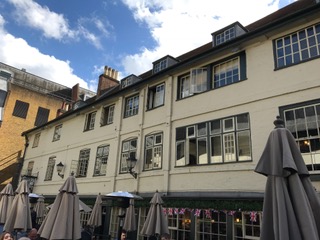Before the fifteenth century, public dining was an unusual sight in the City of London. Meals were devoured in the home. But, slowly, a public sphere developed, particularly in Southwark, where inns and public houses would become the pleasure ground of Londoners and outsiders. Inns started popping up in London in the late fourteenth century, converted from the empty properties that were a consequence of the Black Death. Inns provided meals for passing travellers, as well as lodging and stables. In 1381, 22 new inns had established themselves in Southwark.

The meals provided by the inns primarily consisted of bread, meat, and ale or beer. It was not until the end of the century that more elaborate meals were offered. The sixteenth century added a new addition to the menu with the introduction of the “ordinary” meal. Martha Carlin argues that this might have sprung up due to price regulations, to enable prices that the urban poor could afford. An example of such a meal comes from York in 1562, where a supper was a boiled meal or a roast, along with bread, and ale or beer, for four pennies. This illustrates how the inns broke down spatial barriers between travellers and locals, men and women, and higher and lower social groups.
London inns also served as theatre venues. As Laurence Manley notes, inns had less regulations than taverns. Providing lodging allowed inns to remain open after the 9-10 p.m. curfew that taverns were bound to. One example of these theatres in Southwark is the Rose, established in 1587, but the earliest evidence of performances at London inns is 1557. This was not particularly popular amongst London authorities, who took extensive measures to counteract them through municipal proclamations. The aldermen complained in 1588 that Southwark had ‘so many evil disposed and licentious persons as not only fill their own liberties with all kind of disorder but send their infection into the city’.
Anything could occur within the inns of Southwark, as it lay outside of the jurisdiction of the City of London. Disorderly behaviour, prostitution, and as mentioned theatricals among other issues were rife. The condition of Southwark become so much of a concern that in 1327, King Edward III granted a charter, declaring that the ‘Bailiwick of Southwark’, would now be subject to the authority and laws of the City of London. However, the extent to which the charter was a success in curbing the social issues occurring in Southwark is arguably small.

Geoffrey Chaucer wrote of the huge social diversity of public houses in the Canterbury Tales. Hanawalt expanded on the observations of Chaucer, analysing further the contrasts to medieval society that occurred within public houses, describing them as the ‘most complex institutions of medieval social life’. The public house was a very domestic sphere. The notion of inviting a person in to a space and then playing host was, prior to the medieval period considered an act which would occur at a person’s private residence and interactions in hospitality were the role of women. The spaces used within public houses were also considered domesticated, as guests frequented the living areas, halls, and bedrooms of the building. These too were considered feminine rooms within medieval society.
This demonstrates a break down between the roles and norms of men and women within the establishments; but also, a break down in the image of women in general that did not occur outside of the public houses, and remained in contradiction to the norms of medieval society. Women, as observed by Chaucer also frequented the establishments and even further still, completely unaccompanied. The public houses allowed for freedom, which was primarily the reason Southwark was considered problematic within and even after the medieval period. The diversity made social control extremely difficult.
The establishment of public houses in Southwark had a lasting effect on society. Southwark was considered a problematic area to at least the Tudor period. In addition to this, public houses lasted as a sphere free from social norms even into today’s society. Whether alcohol is the attraction or it in the social freedom that can occur within the establishments; public houses remain the second living room of London.
By Aprilia Kemp and Siri Christiansen
Bibliography
Barbara A. Hanawalt, ‘The Host, the Law, and the Ambiguous Space of Medieval London Taverns’, ‘Of Good and Ill Repute’: Gender and Social Control in Medieval England, ed. By Barbara A. Hanawalt, (New York and Oxford: Oxford University Press, 1998).
Ian W. Archer, ‘Government in Early Modern London: The Challenge of the Suburbs’, Proceedings of the British Academy, 107 (2001).
John Noorthouck, ‘Appendix: Charter (Edward I to Edward IV)’, A New History of London Including Westminster and Southwark (London, 1773). British History Online http://www.british-history.ac.uk/no-series/new-history-london/pp784-799 [accessed 28 March 2017].
Lawrence Manley, ‘Why Did London Inns Function as Theatres?’, Huntington Library Quarterly, Vol. 71, No. 1 (March 2008).
Martha Carlin, ‘What say you to a piece of beef and mustard?’: The Evolution of Public Dining in Medieval and Tudor London’, in Huntington Library Quarterly, 71:1 (2008).
‘The borough of Southwark: Introduction’, A History of the County of Surrey: Volume 4, ed. H E Malden (London, 1912). British History Online http://www.british-history.ac.uk/vch/surrey/vol4/pp125-135 [accessed 28 March 2017].